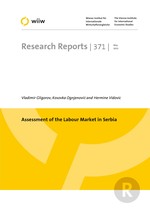Assessment of the Labour Market in Serbia
Vladimir Gligorov, Kosovka Ognjenović and Hermine Vidovic
wiiw Research Report No. 371, May 2011
97 pages including 45 Tables and 11 Figures
Summary German (PDF) Summary French (PDF) Summary Serbian (PDF)
This report has also been published at the EU’s website: http://ec.europa.eu
Summary
In the period after the political changes in the year 2000, GDP growth in Serbia was rather rapid and compares favourably with other transition countries in Southeastern Europe. It was driven mainly by the expansion of services, with industrial production and agriculture basically stagnating over the whole period. The labour market effects were similar to those in other countries going through transition: employment declined in the public sector and increased in the private sector, with the overall number of employed declining and those unemployed increasing, and also with strong increases in the number of pensioners.
The Serbian labour market is characterized by low employment and activity rates, particularly for women and young people. This indicates the weaknesses of the secondary educational system in adapting to the needs of the labour market, but also the obsolete skills of the high percentage of long-term unemployed. In general, the educational attainments of the workforce have changed only marginally over recent years.
Labour mobility, as everywhere in Europe, is very low in Serbia. By contrast, Serbia’s (outward) migration is very high and remittances constitute an important share of income. Brain drain has become an important issue in recent years though it is hardly a new phenomenon. However, for highly educated people, the relevant labour market is the world labour market.
Informal sector employment, which has been traditionally high in Serbia, even increased during the past decade, with a rising share of older workers, better educated persons with secondary education or more, self-employed persons and unpaid family workers. During the current crisis there has been a marked decline in the number of self-employed persons, which is where most informally employed people are to be found.
Serbia has not relied on consistent labour market policies to address the low level of employment and high level of unemployment. Some changes are being introduced in the crisis and post-crisis periods, but the effects are uncertain and are yet to be determined in any case. Although spending on passive and active labour market policy measures in Serbia has been growing in the past couple of years, it is still low compared to the EU average but higher than in most other Western Balkan countries. The lion’s share of the available budget is spent on passive measures.
An important step in order to improve the efficiency of labour market policy measures was made in 2007, when the administration of health insurance was separated from the NES which absorbed much time and efforts in the past.
Transition and the current crisis have led to the development of significant structural problems in the labour markets in Serbia. The policies so far have been inadequate as they have been targeting cyclical rather than structural problems. This needs to be changed in the future with significant improvements in the policy design and the institutional support for implementation.
Keywords: labour market, wage developments, skill mismatch, informal economy, labour market policies
JEL classification: J08, J21, J24, J31, J43, J64
Countries covered: Serbia
Research Areas: Labour, Migration and Income Distribution
